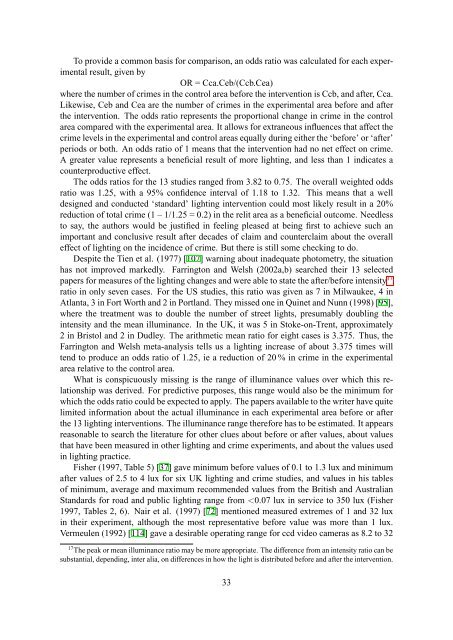outdoor lighting and crime, part 1 - Astronomical Society of Victoria
outdoor lighting and crime, part 1 - Astronomical Society of Victoria
outdoor lighting and crime, part 1 - Astronomical Society of Victoria
You also want an ePaper? Increase the reach of your titles
YUMPU automatically turns print PDFs into web optimized ePapers that Google loves.
To provide a common basis for comparison, an odds ratio was calculated for each experimental<br />
result, given by<br />
OR = Cca.Ceb/(Ccb.Cea)<br />
where the number <strong>of</strong> <strong>crime</strong>s in the control area before the intervention is Ccb, <strong>and</strong> after, Cca.<br />
Likewise, Ceb <strong>and</strong> Cea are the number <strong>of</strong> <strong>crime</strong>s in the experimental area before <strong>and</strong> after<br />
the intervention. The odds ratio represents the proportional change in <strong>crime</strong> in the control<br />
area compared with the experimental area. It allows for extraneous influences that affect the<br />
<strong>crime</strong> levels in the experimental <strong>and</strong> control areas equally during either the ‘before’ or ‘after’<br />
periods or both. An odds ratio <strong>of</strong> 1 means that the intervention had no net effect on <strong>crime</strong>.<br />
A greater value represents a beneficial result <strong>of</strong> more <strong>lighting</strong>, <strong>and</strong> less than 1 indicates a<br />
counterproductive effect.<br />
The odds ratios for the 13 studies ranged from 3.82 to 0.75. The overall weighted odds<br />
ratio was 1.25, with a 95% confidence interval <strong>of</strong> 1.18 to 1.32. This means that a well<br />
designed <strong>and</strong> conducted ‘st<strong>and</strong>ard’ <strong>lighting</strong> intervention could most likely result in a 20%<br />
reduction <strong>of</strong> total <strong>crime</strong> (1 – 1/1.25 = 0.2) in the relit area as a beneficial outcome. Needless<br />
to say, the authors would be justified in feeling pleased at being first to achieve such an<br />
important <strong>and</strong> conclusive result after decades <strong>of</strong> claim <strong>and</strong> counterclaim about the overall<br />
effect <strong>of</strong> <strong>lighting</strong> on the incidence <strong>of</strong> <strong>crime</strong>. But there is still some checking to do.<br />
Despite the Tien et al. (1977) [107] warning about inadequate photometry, the situation<br />
has not improved markedly. Farrington <strong>and</strong> Welsh (2002a,b) searched their 13 selected<br />
papers for measures <strong>of</strong> the <strong>lighting</strong> changes <strong>and</strong> were able to state the after/before intensity 17<br />
ratio in only seven cases. For the US studies, this ratio was given as 7 in Milwaukee, 4 in<br />
Atlanta, 3 in Fort Worth <strong>and</strong> 2 in Portl<strong>and</strong>. They missed one in Quinet <strong>and</strong> Nunn (1998) [95],<br />
where the treatment was to double the number <strong>of</strong> street lights, presumably doubling the<br />
intensity <strong>and</strong> the mean illuminance. In the UK, it was 5 in Stoke-on-Trent, approximately<br />
2 in Bristol <strong>and</strong> 2 in Dudley. The arithmetic mean ratio for eight cases is 3.375. Thus, the<br />
Farrington <strong>and</strong> Welsh meta-analysis tells us a <strong>lighting</strong> increase <strong>of</strong> about 3.375 times will<br />
tend to produce an odds ratio <strong>of</strong> 1.25, ie a reduction <strong>of</strong> 20 % in <strong>crime</strong> in the experimental<br />
area relative to the control area.<br />
What is conspicuously missing is the range <strong>of</strong> illuminance values over which this relationship<br />
was derived. For predictive purposes, this range would also be the minimum for<br />
which the odds ratio could be expected to apply. The papers available to the writer have quite<br />
limited information about the actual illuminance in each experimental area before or after<br />
the 13 <strong>lighting</strong> interventions. The illuminance range therefore has to be estimated. It appears<br />
reasonable to search the literature for other clues about before or after values, about values<br />
that have been measured in other <strong>lighting</strong> <strong>and</strong> <strong>crime</strong> experiments, <strong>and</strong> about the values used<br />
in <strong>lighting</strong> practice.<br />
Fisher (1997, Table 5) [37] gave minimum before values <strong>of</strong> 0.1 to 1.3 lux <strong>and</strong> minimum<br />
after values <strong>of</strong> 2.5 to 4 lux for six UK <strong>lighting</strong> <strong>and</strong> <strong>crime</strong> studies, <strong>and</strong> values in his tables<br />
<strong>of</strong> minimum, average <strong>and</strong> maximum recommended values from the British <strong>and</strong> Australian<br />
St<strong>and</strong>ards for road <strong>and</strong> public <strong>lighting</strong> range from
















